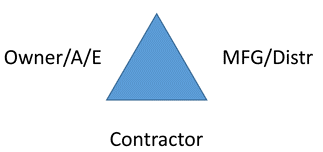Paint giants in the United States have stores and centers throughout the country. This gives the contractor immediate access to the products needed. However, there are several specialty and global manufacturers that do business in the United States and do not have the same distribution outlets. Historically, these companies have sold directly to the contractor with limited distribution warehouses at some locations in the country. But these companies are making a paradigm shift in how they go to market. They are setting up experienced distributors throughout the United States to compete with the paint giants. They must get the product and services closer to the decision makers, meaning the specifiers/engineers/architects and the owners. Why does this matter to the contractor? Mainly because this shift can affect who and how you work with the manufacturers.
The Distributor’s Role
The three main parties in this model are the owner or architect/engineer working on the owner’s behalf, the manufacturer or distributor selling the manufacturer’s product, and the contractor. The specialty and global manufacturers recognize that to bring the product closer to the customer they must use qualified distributors to increase gallons and dollars in today’s climate. A qualified distributor is one that has experienced coating personnel on staff as well as relationships with owners, architectural and engineering firms, and contractors.

There is a process to sell a project, and most of these manufacturers today do not have the wherewithal to pursue all of the opportunities that are in the market place. Therefore, these manufacturers consider a qualified distributor a partner to help them navigate those opportunities.
Helping the Contractor
The contracting company is a key decision maker because it is the facilitator on the project. When the applicator arrives on the jobsite, he or she needs the product(s) to be available in a timely fashion. Additionally, he or she may need technical assistance on the job, such as adjusting the specification due to climate, schedule, and/or cost issues. Other assistance on a retrofit project could require hold point inspection by the supplier, changes to surface preparation, and/or adjustments to the coating system. Consequently, waiting for the factory representative to show up would cause a big delay in the project. Therefore, an experienced distributor that can help the contractor meet the requirements of the specification and facilitate on-site needs between the owner and applicator can be beneficial.

Shifting Relationships
The painting and coating industry today is highly technical, especially considering the current trends towards high-solid coatings and special requirements. There is a lot of pressure put on the contractor to do the job correctly, and he or she wants to know there are knowledgeable people that can help when needed. Because these specialty and global coating manufacturers may only have a few experienced personnel in the United States, the contractor must rely on the distributor to fulfill that need. As the paradigm continues to shift between the owner, manufacturer, and contractor, so too do the relationships.
About the Author
Bob Wolf has been in the coatings and linings industry for 47 years. He owns consulting company Corrosion Protection Resolution (CPR) and is a certified NACE Level 3 Coating Inspector and Society for Protective Coatings (SSPC) Protective Coating Specialist. He has been a member of NACE for 28 years, and he is a former Chairman and Trustee of the Florida Chapter of NACE. For more information, contact: Bob Wolf, bobwolfpcs@yahoo.com or bwolf@cp-resolution.com